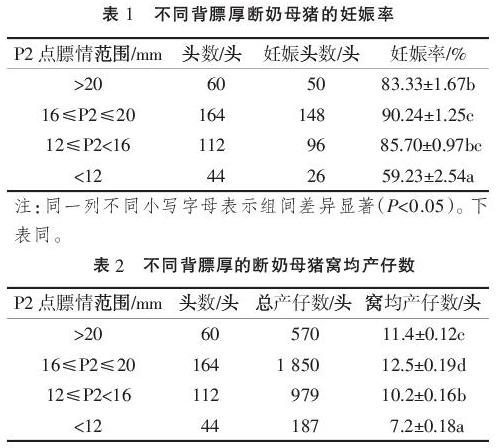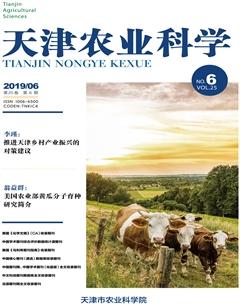断奶母猪不同背膘对定时输精生产效果的影响
刘朝阳 崔茂盛 赵子墨 郑梓 付永利 李奎 李宁 陈亮 李千军


摘 要:背膘是衡量母猪营养体况高低的重要指标,对母猪繁殖性能有较大影响。本试验以妊娠率、窝均产仔数和弱仔数为分析指标,探讨断奶母猪高背膘(P2>20 mm)、中高背膘(16 mm≤P2≤20 mm)、中低背膘(12 mm≤P2<16 mm)和低背膘(P2<12 mm)对定时输精生产成绩的影响,为猪场定时输精生产中母猪背膘精准调控提供理论依据。结果表明,妊娠率表现为中高背膘>中低背膘>高背膘>低背膘,其中中高背膘组与高背膘组差异显著(P<0.05),低背膘组与其他3组差异均显著(P<0.05);窝均产仔数表现为中高背膘>高背膘>中低背膘>低背膘,组间差异均显著(P<0.05);高、中高、中低和低背膘组断奶母猪的窝均弱仔数分别为1.55,1.49,1.56和1.70,组间差异均不显著(P>0.05)。综合而言,断奶母猪中高背膘厚即16≤P2≤20 mm的斷奶母猪繁殖性能最佳,而背膘厚大于20 mm或小于12 mm均会降低母猪妊娠率和产仔数。
关键词:背膘;定时输精;妊娠率;产仔数;弱仔
中图分类号: S828;S814 文献标识码: A DOI 编码:10.3969/j.issn.1006-6500.2019.06.005
Abstract: Backfat is an important index to assess the sow nutritional status, which has a great influence on reproductive performance. In the present study, the pregnancy rate, litter size and weak piglet per litter size were used as indexes to investigate the effects of high (P2>20mm), medium-high (16≤P2≤20mm), medium-low (12≤P2<16) and low backfat (P2<12mm) on the performance of timed insemination in weaned sows, which were expecte to provide a theoretical basis for precise regulation of sows backfat during timed insemination in pig farms. The results in pregnancy rate were expressed as: medium-high backfat >medium-low backfat >high backfat > low backfat and the difference between the high backfat group and the medium-high backfat group were significant(P<0.05), and the difference between the low backfat group and the other three groups was significant(P<0.05). The results of litter size showed as medium-high backfat > high backfat > medium low backfat > low backfat, and the difference between groups was significant(P<0.05). The weak piglets per litter size of weaned sows in the high, medium-high, medium-low and low backfat groups were 1.55, 1.49, 1.56 and 1.70, respectively, and there were no significant difference between groups(P>0.05). In a word, weaned sows with medium-high backfat thickness(16≤P2≤20 mm) had the best reproductive performance, while those with backfat thickness more than 20 mm or less than 12 mm could reduce the pregnancy rate and litter size.
Key words: backfat; timed insemination; pregnancy rate; litter size; weak piglet
目前经产母猪定时输精技术通常为在断奶后24 h肌注1 000 IU的孕马血清(PMSG),再过72 h 后肌注100 μg的促性腺素释放激素(GnRH),之后24 h第1次人工输精,再过16 h后进行第2次人工输精[1]。猪定时输精是近几年开始推广的繁殖新技术,使原有的连续生产模式转换为间隔分明、规律明显的批次生产模式。该生产模式的转变具有提高猪群健康水平、减少药物投入、提升母猪繁殖性能,增加产仔数以及提高员工劳动效率、降低生产成本等诸多优点[2]。在经产母猪的定时输精生产中,有2种外源生殖激素(孕马血清和促性腺激素释放激素)协助母猪发情、卵泡发育和排卵,促进了母猪繁殖性能的提高[3]。猪场的这种生产模式源于工业批次化、标准化、模式化管理,能够充分挖掘猪场母猪的生产潜能,充分利用各种生产资源,提高猪场经济效益[4]。

